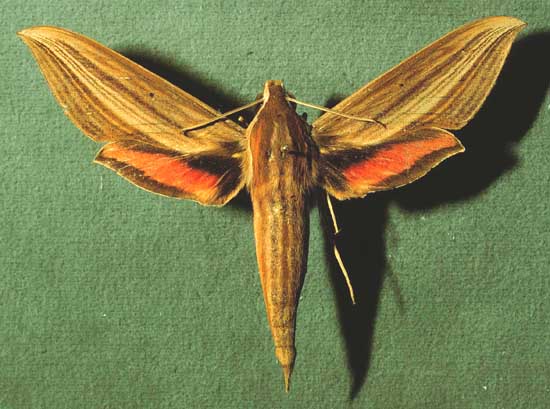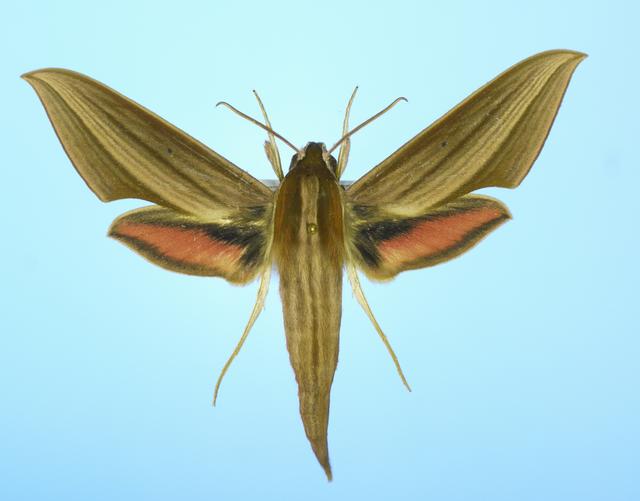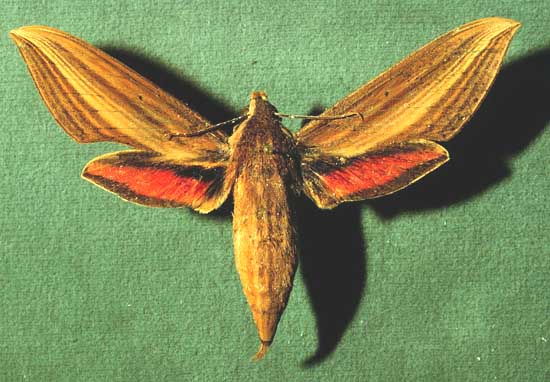Xylophanes cthulhu
zail-AH-fan-eesmm
kuh-THUL-who
Haxaire & Vaglia, 2008,

Xylophanes cthulhu male, Costa Rica, courtesy of Dan Janzen.
This site has been created by
Bill Oehlke at oehlkew@islandtelecom.com
Comments, suggestions and/or additional information are welcomed by Bill.
TAXONOMY:
Family: Sphingidae, Latreille, 1802
Subfamily: Macroglossinae, Harris, 1839
Tribe: Macroglossini, Harris, 1839
Genus: Xylophanes Hubner [1819] ...........
Species: cthulhu Haxaire & Vaglia, 2008,
|
MIDI MUSIC
.....It's a Wonderful World.....
copyright C. Odenkirk
ON.OFF
<bgsound src="world.mid" LOOP=FOREVER>
|
DISTRIBUTION:
Xylophanes cthulhu moths (wingspan: 76 - 82 mm)
fly in
Guatemala: Izabal; and
Costa Rica; and possibly in other Central America countries.

Xylophanes cthulhu, Coban, near Alta Verapaz, Guatemala,
October 27, 2010, courtesy of Mark Vincent.
Mark Vincent writes, "Xylophanes cthulhu is distinguishable from Xylophanes neoptolemus
by being brighter with a more acutely falcate tip to the forewing, a pure black basal area to the hindwing and by the golden yellow band between the
1rst and 4th postmedian lines on the forewing underside (contrasting with the reddish orange tone of the ground colour of the rest of the wing).
X. neoptolemus is less brightly coloured with a less contrasting upperside forewing pattern, no golden yellow band on the forewing underside but with a
distinct dashed postmedian line marked by black vein dots on both the forewing and hindwing underside.
"X. cthulu is widespread in lowland rainforest throughout Central America.
"It appears that it is replaced in South America by X. neoptolemus."
FLIGHT TIMES:
Xylophanes cthulhu adults fly all year in Costa Rica.
ECLOSION:
Pupae probably wiggle to surface from subterranean chambers or leaf litter just prior to
eclosion.

Xylophanes cthulhu female courtesy of Dan Janzen.
SCENTING AND MATING:Females call in the males with a pheromone released from a gland at the tip of the
abdomen. Males come in to lights very readily, but females are
seldom taken in that way.
EGGS, LARVAE, PUPAE:
The snake-like larva has a head and the three thoracic segments which may be retracted
into abdominal segment 1, which is swollen and adorned with a pair of light-ringed grey eye-spots.


Images courtesy of Dan Janzen.
In Costa Rica, Dan Janzen reports larvae on Ludwigia
in the Onagraceae family.
Moths emerge about four weeks after pupation.
Use your browser "Back" button to return to the previous page.
Goto Main Sphingidae Index
Goto Macroglossini Tribe
Goto Central American Indices
Goto Carribean Islands
Goto South American Indices
Goto U.S.A. tables
The pronunciation of scientific names is
troublesome for many. The "suggestion" at the top of the page is
merely a suggestion. It is based on commonly
accepted English pronunciation of Greek names and/or some
fairly well accepted "rules" for latinized scientific names.
The suggested pronunciations, on this page and on other pages,
are primarily put forward to assist those who hear with internal
ears as they read.
There are many collectors from different countries whose
intonations and accents would be different.
Jean Marie Cadiou writes, "When I say "Xylophanes" in English I
pronounce it something like "Zailophanees", with the emphasis on the
"o". The French pronounce it differently, something like
"Kzeelophaness" with no emphasis, and the Germans yet in a
different way..."
"Xylophanes" sounds like it is from Greek mythology.
The species name, "Neoptolemus" is from Greek mythology.
Neoptolemus, also called Pyrrhus, was the only son of Achilles and
grandson of Peleus. Neoptolemus was a young, cruel and ferocious
warrior who later became king of Epirus and was finally
murdered in Apollo's temple at Delphi.
Use your browser "Back" button to return to the previous page.
This page is brought to you by
Bill Oehlke and the
WLSS. Pages are on space rented from Bizland. If you would like
to become a "Patron of the Sphingidae Site", contact Bill.
Please send sightings/images to Bill. I will do my best to respond to
requests for identification help.
Enjoy one of nature's wonderments: Live
Saturniidae (Giant Silkmoth) cocoons.
 | 
Show appreciation for this site by clicking on flashing butterfly to the left.
The link will take you to a page with links to many insect sites. |






